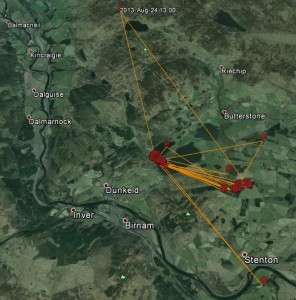Osprey Diary Tues 27th August
Hello folks, Emma the ranger here again, saying a big thankyou to the rest of the Loch of the Lowes team for keeping the blog updated with wildlife news whilst I was unavailable for a few days. Today is no exception, with my wonderful team of three trainee Assistant Ranger volunteers preparing most of this information- thanks Rachel, Sarah and Shayl.
It seems like our Osprey juvenile Blue YZ is getting into a bit of a flying routine. When analysing our recent satellite tracking data, we have noticed she takes a nice 11am flight most days to explore the local area. For example on each of the 19th, 20th and 21st August at 11am, she went flying at Loch of the Lowes, then at Butterstone Loch, then further afield.
It also looks like Blue YZ has been exploring a bit more widely as we would expect at this age – no doubt in preparation for her flight south to Africa. From our satellite tracking system, we can see she has done two major flights in the last few days:
21st August, 11am – Flying 4.7km from Loch of the Lowes, over the River Tay, just south of Stenton and Caputh.
24th August, 1pm – Flying at her furthest recorded point, 7.4km from Loch of the Lowes, north of Loch Ordie.
Although these are Blue YZ’s furthest recorded flights, this does not necessarily mean that she has not explored further already. As the tracker only records GPS locations once an hour, we can only work with the data we receive. If anyone spots Blue YZ further afield, and can manage to photograph her with her ring, please do get in touch!

In other Loch of the Lowes news – we had a fantastic visit today from the Royal School of Dunkeld’s P7 class. These enthusiastic pupils helped Emma and her ranger team, carry out a Bioblitz of the reserve, learning real survey skills. For anyone who hasn’t come across a ‘Bioblitz’ before, they involve counting all the species in an area to work out how biodiverse (i.e. naturally varied, and therefore ‘healthy’) it is.
The pupils helped us with plant quadrat surveys, bird counts, insect ID and even a fish survey! We are delighted with the results. Here are the total counts of different types of animals and plants we found in only 2 hours:
BIRDS Woods – 15
Loch – 9
MAMMALS 5
INSECTS 22
FISH 2
REPTILES/AMPH 2
Meadow PLANTS 12
GRAND TOTAL = 67 DIFFERENT SPECIES AT LOCH OF THE LOWES SIGHTED IN 2 HOURS.
Thank you to the Royal School of Dunkeld for all your help, and we’re looking forward to coming to your school soon to help you with your very own Bioblitz.
Osprey Q and A:
Q: Is the osprey satellite tagging done at the same time as ringing or at a separate time?
A: The tag that Blue YZ is carrying was fitted at the same time as ringing ( on 15th July) to minimise stress- only one removal from nest and only once in her life she will be handled hopefully.
Q: Last week some pictures were posted of Lady having a bath. Was she in shallow water? I wondered because if they get water logged can’t they drown? Is an osprey able to take flight from the water surface?
A: What great questions- you are of course correct in that ospreys are not fully waterproof and can become water logged and drown if dragged under water. Most birds bath in water to keep their feathers and skin healthy, and the slight oiliness in most feathers makes most water run off easily. Ospreys also shake vigorously to remove excess after diving for fish or bathing in shallows. They then often sit up on a tree and preen to smooth their feathers and dry out fully. Ospreys can take off from the water’s surface , but not like a duck ( running with webbed feet) over the surface. They do so with an enormous pull of the wings straight up which tells you just how strong they are- often with a heavy fish in tow!
Q: Whilst fishing on The Tay on Monday evening the 19th I saw three Ospreys calling and circling near Dunkeld. Could this have been BlueYZ plus parents?
A: Lucky you seeing three ospreys at once! The Tay is a common place to see the local birds in action, and there are also more northerly ospreys now starting to pass through too. During autumn migration time it is not uncommon to see birds together, though ospreys do not travel in family groups. For example, we know our adult female at Loch of the Lowes has already left and that her mate and her chick are still here so it could have been these two, or other local or passing ospreys.
Help protect Scotland’s wildlife
Our work to save Scotland’s wildlife is made possible thanks to the generosity of our members and supporters.
Join today from just £3 a month to help protect the species you love.
Preface
Hello folks, Emma the ranger here again, saying a big thankyou to the rest of the Loch of the Lowes team for keeping the blog updated with wildlife news whilst …
